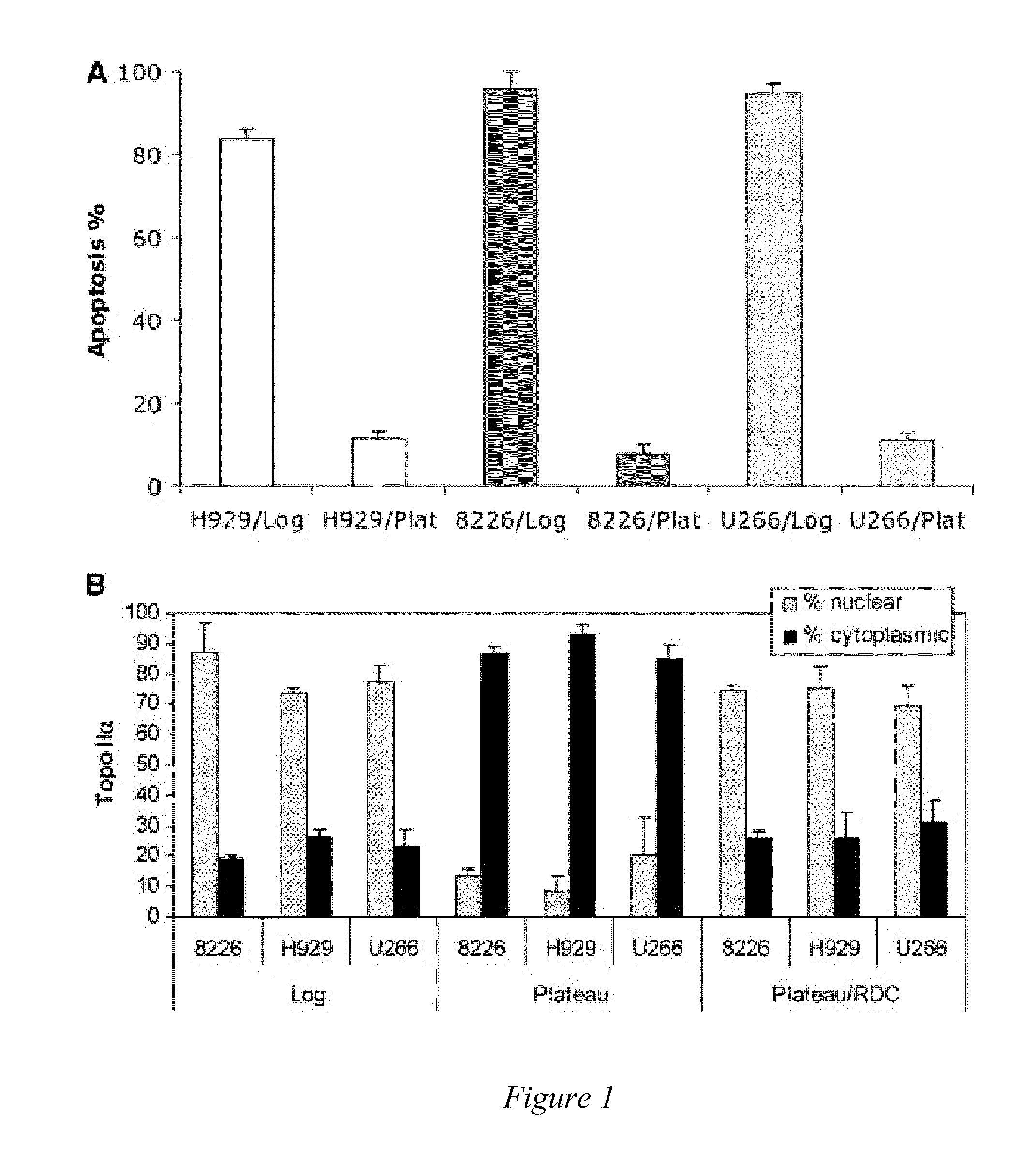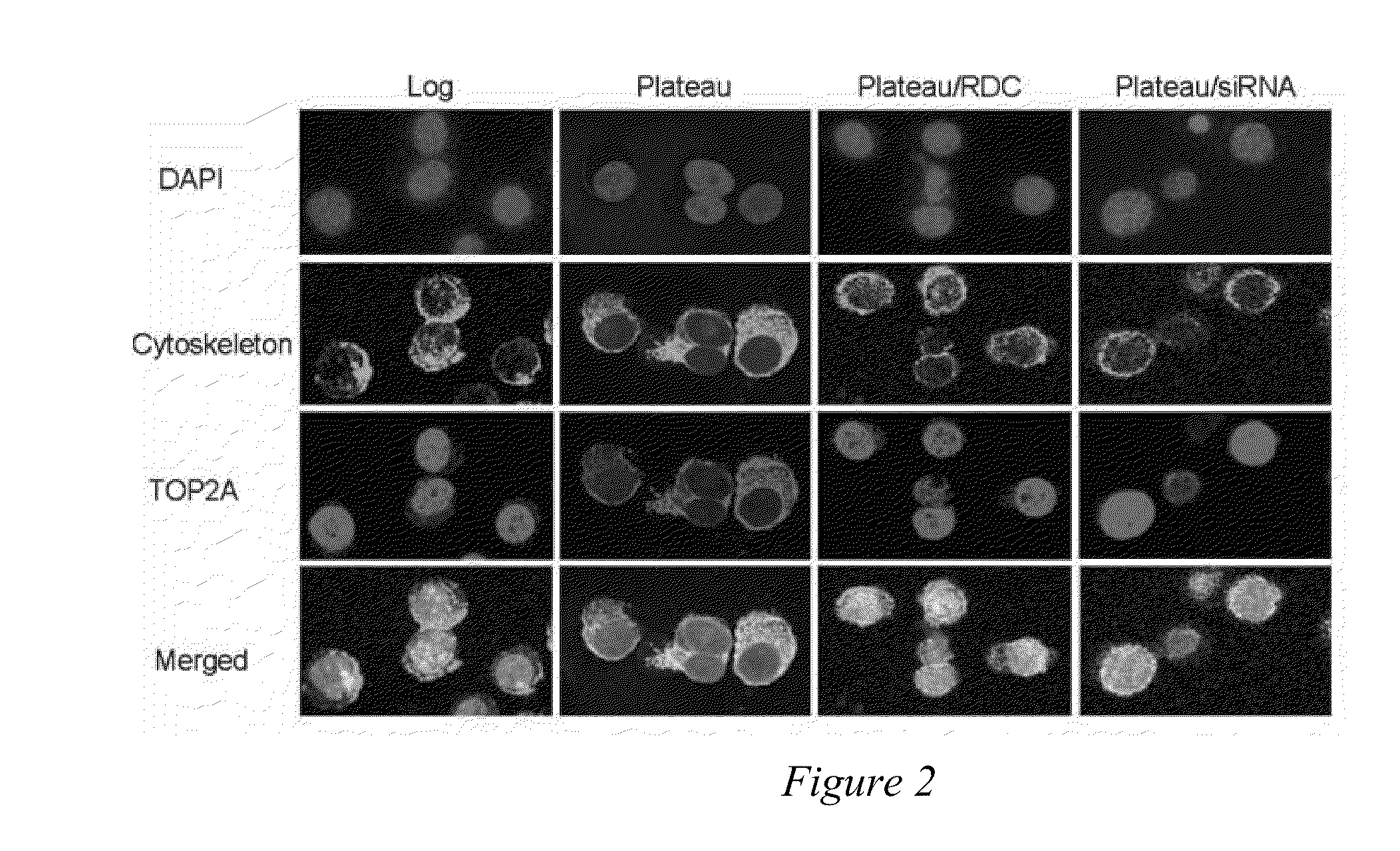Nuclear export inhibitors of topoisomerase ii alpha
- Summary
- Abstract
- Description
- Claims
- Application Information
AI Technical Summary
Benefits of technology
Problems solved by technology
Method used
Image
Examples
example 1
CRM1 Inhibition Sensitizes Human Multiple Myeloma Cells to Topoisomerase II Inhibitors
[0068]The intracellular location of a protein may be at least as important as its expression. Diseases as dissimilar as cystic fibrosis, schizophrenia [Karpa K D, et al., Mol Pharmacol (2000)58:677-83], nephrogenic diabetes insipidus, and many types of cancers, as reviewed previously [Davis J R, et al., Pharm Res (2007)24:17-27], may be caused by intracellular mislocalization of individual proteins. Specific examples of proteins that must be in the nucleus to prevent cancer initiation, progression, or chemotherapeutic response include p53 [Fabbro M, et al., Exp Cell Res (2003)282:59-69], galectin-3 [Takenaka Y, et al., Mol Cell Biol (2004)24:4395-406], FOXO [Nakamura N, et al., Mol Cell Biol (2000)20:8969-82], INI1 / hSNPF5 [Craig E, et al., EMBO J. (2002)21:31-42], p27Kip1 [Min Y H, et al., Cancer Res (2004)64:5225-31], p21Cip1, and topo IIα [Valkov N I, et al., Br J Haematol (2000)108:331-45; Turne...
example 2
Small Molecule Inhibitors of Nuclear Export of Topoisomerase IIα for the Treatment of Cancer
[0091]Topo IIα is exported from the nucleus of human multiple myeloma (MM) cells by a CRM1-dependent mechanism [Engel et al, Exp. Cell Res. (2004)295(2):421-31]. Moreover, topo IIα has nuclear export signals (NES) at amino acids 1017-28 and 1054-66 [Turner et al, J. Cell Sci. (2004)117:3061-71]. Drug resistance to topo II poisons occurs when topo II is trafficked to the cytoplasm where it is not in contact with the DNA, and thus unable to induce cell death. In addition, the inventors have shown above that blocking nuclear export with a CRM1 inhibitor or by siRNA sensitizes MM cells to topo II poisons.
[0092]In furtherance of the showing above in Example 1, the inventors have identified a group of 20 small molecule inhibitors (SMI) effective in the treatment of multiple myeloma (MM) and perhaps other cancers. In vitro data indicates that these drugs can be utilized as single agents or in combin...
example 3
Blocking a Topo IIα Nuclear Export Signal Sensitizes Human Multiple Myeloma Cells to Topo IIα Inhibitors
[0098]Topoisomerase IIα is exported from the nucleus of human multiple myeloma (MM) cells by a CRM1-dependent mechanism (Engel et al, Exp. Cell Res. 295(2):421-31, 2004). Nuclear export signals (NES) for topo IIα have been identified at amino acids 1017-28 (site 1) and 1054-66 (site 2) using mutated full-length FLAG-tagged topo IIα protein and immunofluorescence microscopy, (Turner et al, J. Cell Sci. 117:3061-71, 2004). Drug resistance to topo II poisons occurs when topo II is trafficked to the cytoplasm where it is not in contact with the DNA, and thus unable to induce cell death. In addition, blocking nuclear export with a CRM1 inhibitor or by siRNA sensitizes MM cells to topo II poisons, (Turner and Sullivan, Cancer Res. 69(17): 6899-6905, Sep. 1, 2009).
[0099]The structure of S. cerevisiae topo II was used to create a model of human topo IIα using the program PhyreA. The proce...
PUM
 Login to View More
Login to View More Abstract
Description
Claims
Application Information
 Login to View More
Login to View More - R&D Engineer
- R&D Manager
- IP Professional
- Industry Leading Data Capabilities
- Powerful AI technology
- Patent DNA Extraction
Browse by: Latest US Patents, China's latest patents, Technical Efficacy Thesaurus, Application Domain, Technology Topic, Popular Technical Reports.
© 2024 PatSnap. All rights reserved.Legal|Privacy policy|Modern Slavery Act Transparency Statement|Sitemap|About US| Contact US: help@patsnap.com










